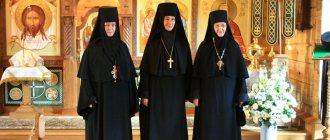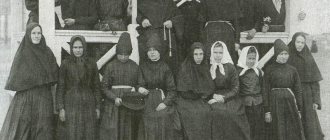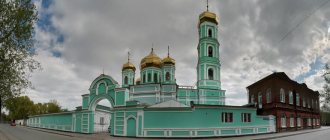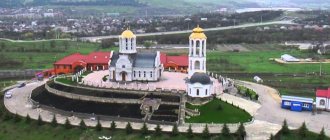Mir
Russia Rostov region Rostov-on-Don Iversky Convent (Rostov-on-Don) Map is loading…
{"format":"leaflet","minzoom":false,"maxzoom":false,"limit":50,"offset":0,"link":"all","sort":[""], "order":[],"headers":"show","mainlabel":"","intro":"","outro":"","searchlabel":"\u2026 \u0441\u043b\u0435\ u0434\u0443\u044e\u0449\u0438\u0435 \u0440\u0435\u0437\u0443\u043b\u044c\u0442\u0430\u0442\u044b","default":"","import-annotation":false,"width ":"auto","height":"350px","centre":{"text":"","title":"""link":"""lat":47.2831120000000026948328013531863689422607421875,"lon": 39.69778800000000273939804174005985260009765625,"icon":""},"title":"","label":"","icon":"","lines":[],"polygons":[], "circles":[ ],"rectangles":[],"copycoords":false,"static":false,"zoom":8,"defzoom":14,"layers":["OpenStreetMap"],"image layers":[] ,"overlays":[],"resizable":false,"fullscreen":true,"scrollwheelzoom":true,"cluster":false,"clustermaxzoom":9,"clusterzoomonclick":true,"clustermaxradius":80, "clusterspiderfy":true,"geojson":"","clicktarget":"","showtitle":true,"hidenamespace":false,"template":"","userparam":"","activeicon": "","pagelabel":false,"ajaxcoordproperty":"","ajaxquery":"","locations":[{"text":"\u003Cb\u003E\u003Ca href=\"/palomnik/%D0% 90%D0%BB%D0%B5%D0%BA%D1%81%D0%B0%D0%BD%D0%B4%D1%80%D0%BE-%D0%9D%D0%B5%D0%B2 %D1%81%D0%BA%D0%B8%D0%B9_%D0%98%D0%B5%D1%80%D1%83%D1%81%D0%B0%D0%BB%D0%B8%D0 %BC%D1%81%D0%BA%D0%B8%D0%B9_%D0%B3%D1%80%D0%B5%D1%87%D0%B5%D1%81%D0%BA%D0%B8 %D0%B9_%D0%BC%D1%83%D0%B6%D1%81%D0%BA%D0%BE%D0%B9_%D0%BC%D0%BE%D0%BD%D0%B0%D1 %81%D1%82%D1%8B%D1%80%D1%8C\" title=\"\u0410\u043b\u0435\u043a\u0441\u0430\u043d\u0434\u0440\u043e-\u041d\u0435\ u0432\u0441\u043a\u0438\u0439 \u0418\u0435\u0440\u0443\u0441\u0430\u043b\u0438\u043c\u0441\u043a\u0438\u0439 \u0433\u0440\u0 435\u0447\u0435\u0441\u043a\ u0438\u0439 \u043c\u0443\u0436\u0441\u043a\u043e\u0439 \u043c\u043e\u043d\u0430\u0441\u0442\u044b\u0440\u044c\"\u003E\u0410\ u043b\u0435\u043a\u0441\ u0430\u043d\u0434\u0440\u043e-\u041d\u0435\u0432\u0441\u043a\u0438\u0439 \u0418\u0435\u0440\u0443\u0441\u0430\u043b\u0438\u0 43c\u0441\u043a\u0438\u0439 \u0433\u0440\u0435\u0447\u0435\u0441\u043a\u0438\u0439 \u043c\u0443\u0436\u0441\u043a\u043e\u0439 \u043c\u043e\u043d\u0430\ u0441\u0442\u044b\u0440\u044c \u003C/a\u003E\u003C/b\u003E\u003Chr /\u003E\u003Ca href=\»/palomnik/%D0%A1%D0%B2%D0%BE%D0%B9%D1%81%D1%82 %D0%B2%D0%BE:%D0%90%D0%BD%D0%BD%D0%BE%D1%82%D0%B0%D1%86%D0%B8%D1%8F\» title=\ »\u0421\u0432\u043e\u0439\u0441\u0442\u0432\u043e:\u0410\u043d\u043d\u043e\u0442\u0430\u0446\u0438\u044f\»\u003E\u0410\u043 d\u043d\u043e\u0442 \u0430\u0446\u0438\u044f\u003C/a\u003E: \u043f\u0440\u0430\u0432\u043e\u0441\u043b\u0430\u0432\u043d\u044b\u0439 \u043c\u04 43\u0436\u0441\u043a\ u043e\u0439 \u043c\u043e\u043d\u0430\u0441\u0442\u044b\u0440\u044c, \u043e\u0441\u043d\u043e\u0432\u0430\u043d\u043d\u044b\u 0439\u0432 1903\u0433\u043e\ u0434\u0443. 1929 1929 0\u0430\u0449\u0435\u043d\u0426 \u0435\u0440\u043a\u0432\u0438 \u0432 1991 \u0433\u043e\u0434\u0443. \u041f\u0440\u0438 \u043c\u043e\u043d\u0430\u0441\u0442\u044b\u0440\u0435 \u0434\u0435\u0439\u0441\u0442\u0432\u0443\u0435\ u0442\u0433\u043e\u0441\u0442 \u0438\u043d\u0438\u0446\u0430.","title":"\u0410\u043b\u0435\u043a\u0441\u0430\u043d\u0434\u0440\u043e-\u041d\u0435\u0432\u0441\ u043a\ u0438\u0439 \u0418\u0435\u0440\u0443\u0441\u0430\u043b\u0438\u043c\u0441\u043a\u0438\u0439 \u0433\u0440\u0435\u0447\u0435\u0 441\u043a\u0438\u0439\u043c\ u0443\u0436\u0441\u043a\u043e\u0439 \u043c\u043e\u043d\u0430\u0441\u0442\u044b\u0440\u044c","link":""lat":47.28311200000000269483 28013531863689422607421875,"lon":39.69778800000000273939804174005985260009765625, "icon":""}],"imageLayers":[]}
47.273234; 39.692645
Russia, Rostov-on-Don, Sovkhozny quarter
Rostov-on-Don, Rostov region
Russia
Telephone:
8 (863) 235-41-63 (automatic switching to answering machine /fax/ after the 3rd ring) or 8-951-494-03-89. Please call from 11.00 to 17.00.
The Holy Iversky Monastery is currently the only convent in the Rostov diocese. Today, 35 nuns live in the monastery. Built between 1903 and 1905.
History[edit]
The history of the monastery began in 1903, when the Rostov administration fulfilled the request of the nuns of the Black Sea Monastery Ekaterina and Alexandra, allocating a plot of land near the city of Rostov-on-Don for the construction of a convent. The merchant S.I. Fedorov became a trustee, and in 1905 he ordered the design of a small stone monastery church from the architect N.M. Sokolov. In 1908, the construction of the temple was completed and it was consecrated in honor of the Iveron Icon of the Mother of God.
During the First World War, the monastery premises were used as a shelter for orphan girls from occupied Poland. And after the October Revolution in 1917, Mother Superior Anastasia, due to the threat of closing the temple, re-registered it as an agricultural artel. However, in 1929 the temple was closed, and the abbess and several sisters were sent to Siberia, transferring the temple property to the state. After the closure of the temple, the temple buildings at various times housed a state farm club, an orphanage, workshops and warehouses.
The revival of the temple happened only after the collapse of the USSR - the Iversky Convent was restored by a decree of the Holy Synod of the Russian Orthodox Church on August 30, 1991.
Recovery period
Orthodox Christians did not accept the dilapidated state of the ancient shrine and formed an initiative group, headed by the ruling bishop Vladimir (Sabodan).
With the support of Bishop Vladimir, the monastery of the Icon of the Mother of God of Iveron was returned to the Church.
- The first services began to be held in the Church of Demetrius of Rostov; in 1991, the Holy Synod officially announced the opening of a women’s monastery in Rostov-on-Don.
- In 1992, Metropolitan Vladimir (Sabodan) presented the monastery with the holy image of the Mother of God “Iverskaya”, which was painted on the holy Mount Athos.
- At the expense of benefactors and the administration of Rostov, the revival of the desecrated shrine began, which since 1993 has been headed by Abbess Neonilla.
Interior of the Iversky Monastery
The nuns, nuns and Mother Neonilla set about building cells, improving the spring and the front garden with roses, they planted vegetable gardens, planted new trees in the garden, and resumed raising livestock and poultry.
At the same time, the restoration of the temple and bell tower was going on, the bells of which were heard by Rostovites in 1995.
In 1996, the five-domed monastery complex was restored from the outside, and interior work began.
At this time, Mother Neonilla fell ill, and 3 years later she rested with God.
In 1996, the leadership of the monastery in Rostov-on-Don was entrusted to the nun Rachel, a year later she was elevated to the rank of abbess and became the abbess of the monastery.
November 3, 1996 became a significant day in the life of the convent. Archbishop Panteleimon (Dolganov) consecrated the upper church in honor of the holy face of the Mother of God “Iverskaya”, after which parishioners could attend services every day.
By the end of 2002, the painting of the walls and renovation of the iconostasis in the lower aisle were completely completed.
Current state[edit]
By the fall of 2002 Through the efforts of Rostov restoration artists, the walls were painted and the iconostasis of the lower church was updated. Many parishioners, benefactors, and sisters took part in the renovation of the church with great care. And the chronicle of the monastery was replenished with another significant event, testifying to the prosperity of the monastery under the protection of the Queen of Heaven: November 17, 2002. His Eminence Vladyka Panteleimon performed the great consecration of the restored church in honor of St. Demetrius, Metropolitan of Rostov.
Holy Iversky Convent of Rostov-on-Don Diocesan monasteries of the Russian Orthodox Church
The site was located twelve miles from Rostov and had a spring on its territory, which soon became known for its healing properties. The Rostov merchant S.I. Fedorov became the trustee of the monastery, so the monastery was popularly called “Fedorovsky”. There is a legend that a merchant built a monastery for the sake of his sixteen-year-old daughter, who wished to retire from worldly life. The first abbess of the newly created monastery was Abbess Anastasia, under whose leadership about 50 sisters soon gathered.
A few years later, a wooden chapel - a chapel and cells - rose on the monastery land, which were later replaced with stone ones. A chapel was erected above the healing spring, and next to it was the abbot’s house.
In 1905, by order of S.I. Fedorov, famous architect N.M. Sokolov completed the design of a small stone monastery church. Construction was completed in 1908, and the temple was consecrated in honor of the Iveron Icon of the Mother of God, a copy of which was given to the monastery by its benefactor, the merchant Fedorov.
According to the stories of old-timers, at the end of the summer of 1914, the royal motorcade, returning from the Caucasian Mineralnye Vody, stopped at the border of the monastery land. Emperor Nicholas II and his Heir, Tsarevich Alexy, entered the land of the holy monastery and entered under the arches of the temple to venerate the Iveron Icon of the Mother of God.
With the outbreak of the First World War, the Fedorovsky Monastery took on new concerns. In 1915, the nuns took in orphans aged 9-11 years old, brought to Rostov from occupied Poland. They studied and lived here until the early 1920s.
The February Revolution, the October Revolution, and the civil war were not immediately able to destroy the spiritual unity of the sisters and the way of monastic life. In 1919, when the threat of closing the monastery loomed, Abbess Anastasia found a wise solution: the community was registered as an agricultural artel. During the years of persecution from the godless authorities, the blessed monastic life continued, hiding under the name of an artel.
There were poultry and barnyards, a bakery, a kitchen, a large apiary, an orchard, artificial dams for fish breeding and a beautiful rose garden.
The monastery was closed in 1929. All property was transferred to the ownership of the state. The novices and nuns were expelled from the monastery land, and the seventy-year-old abbess Anastasia and her closest assistants were tried and sent to Siberia for six years. After serving her term of exile, Mother Anastasia moved to a small village in central Russia to live with her lonely niece. But, in 1937, the niece suddenly died, leaving mother alone, sick and weak from the experience. She wrote letters to her spiritual daughters asking for help. The nun sisters responded, came and stayed with her for about a year before her death.
After the monastery was closed, the church dome and bell tower were dismantled, and a pig-feeding state farm club was placed in the church building. In the building where there were monastic cells, they first located an orphanage, then workshops, warehouses, etc. In those post-war years of devastation and state instability, one temporary worker replaced another. As a result, the richest orchard was ruthlessly cut down. For lack of a permanent and interested owner, the apiary died. The chapel, abbot's house, outbuildings and even cobblestone paths were dismantled into stone. The source began to become cluttered, the ponds became overgrown and became swamps. A few years later, the territory of the former monastery turned into a dull wasteland overgrown with weeds, its appearance testifying to the terrible spiritual upheavals that befell all of Russia. But the people's memory lived with memories of the past greatness, beauty, spiritual joy that once reigned here. And people went to the source, which was nicknamed “tears of the Mother of God,” prayer was performed here, and hope glimmered for the future revival of the shrine. Anyone who came to the site of the former monastery, despite all the destruction and desecration, felt here the invisible presence of the Heavenly Patroness.
At the end of the 80s, the Orthodox community of the city turned its attention to the beheaded and desecrated monastery church, which seemed to be crying out for help. With the blessing of the Ruling Bishop, Metropolitan Vladimir (Sabodan), an initiative group was formed whose task was to achieve the return of the shrine to the Russian Orthodox Church. The desecrated shrine was returned to the Church.
The flame of spiritual life lit up in the dilapidated lower church in honor of St. Demetrius of Rostov, where, with the blessing of His Eminence Metropolitan Vladimir, the first services began. In 1991, by the Resolution of the Holy Synod of the Russian Orthodox Church, the Holy Iversky Convent was established in the Rostov diocese. In 1992, Metropolitan Vladimir (Sabodan) donated the Iveron Icon of the Most Holy Theotokos to the monastery, on which the inscription was preserved: “This holy icon was painted and consecrated on the Holy Mount Athos in the Russian St. Andrew’s monastery.” Such great consolation and hope for the intercession of the Mother of God marked the revival of the holy monastery.
Since July 1993 nun Neonilla (Nina Sergeevna Sergienko, 1999) was appointed abbess of the monastery. They rebuilt cells, cleaned and improved the spring, planted vegetable gardens, and began raising livestock and poultry. But the main concern was the monastery church. Over the course of two years, external repair work was carried out, and the bell tower was restored. In the spring of 1996, the original appearance of the five-domed building was restored, and interior decoration of the temple began. In August 1996 Due to health reasons, the abbess, nun Neonilla, was retired, and three years later in 1999. went to the Lord. She was buried in the monastery cemetery.
Since August 1996, nun Rachel (Natalya Filippovna Kovaleva) was appointed senior sister of the monastery, and in 1997. By decree of His Holiness Patriarch Alexy II, on the proposal of His Eminence Panteleimon (Dolganov), Archbishop of Rostov and Novocherkassk, nun Rachel was elevated to the rank of abbess and appointed abbess of the monastery.
On November 3, 1996, the ruling bishop of the Rostov diocese, Archbishop Panteleimon (Dolganov), consecrated the restored upper church in honor of the Iveron Icon of the Mother of God. From that moment on, divine services began to be held there every day.
In 1997 With the feasible contributions of benefactors, they were able to gild the small domes of the church and the bell tower; the iconostasis was painted by the Rostov icon painters of the Diocesan Workshop; a little later, the square in front of the church and the path around it were tiled. The sisters took care to decorate the church yard with numerous flower beds with a variety of flowers and ornamental vegetation.
On the holy days of the celebration of the great Christian holidays of the Nativity of Christ and Epiphany in 2000, a solemn bringing of a copy of the Iveron Icon of the Mother of God from Holy Mount Athos to the Rostov Convent took place. By the fall of 2002 Through the efforts of Rostov restoration artists, the walls were painted and the iconostasis of the lower church was updated. November 17, 2002 His Eminence Vladyka Panteleimon performed the great consecration of the restored church in honor of St. Demetrius, Metropolitan of Rostov.
The confessor of the monastery for several years was Archimandrite Modest (†14.03.02) - the abbot of the Holy Don Monastery of Starocherkassk.
Today, 35 nuns live in the monastery. Observing the rules of the Holy Fathers of ancient monasticism, the Indestructible Psalter is read by the sisters in the monastery. Every day begins and ends with prayer. In the morning at 6.00 all the sisters gather at the temple for a prayer rule in order to raise their first thoughts to God and ask for a blessing for the upcoming deeds. The whole day passes in tireless work: the sisters sing in the choir, work in the barnyard, in the refectory, cultivate the garden, bake prosphora, but in any activity they try to acquire unceasing prayer and with it to enlighten their souls, to make their hearts pure in the Gospel. The day ends with its many worries, and again the sisters gather in church for the evening prayer rule to thank the Lord for His generous mercy and help in all our needs, everyday and spiritual.
Patronal holidays[edit]
Icon of the Most Holy Theotokos “Iverskaya”
- Calendar
- October 26 – brought to Moscow in 1648.
- January 20 – the solemn bringing of a copy of the Iveron Icon of the Mother of God from Holy Mount Athos to the Rostov Convent.
- 25 February.
- The third day of Easter is Tuesday of Holy Week.
Demetrius of Rostov, saint
— October 4 (discovery of relics), November 10
Royal Day - the day of remembrance of the Holy Royal Passion-Bearers:
- July 17 - cathedral service of the Divine Liturgy and procession around the monastery territory in honor of the holy Royal Passion-Bearers.
Service Schedule
To visit the monastery not only for the purpose of an excursion, but also to pray and bow before the miraculous icon, it would not be amiss to familiarize yourself with the schedule of services of the Iversky Monastery.
The monastery is open to visitors from 7-00 to 21-00. Divine services in churches on weekdays are held from 7-00 to 9-00 and from 18-00 to 20-00.
- 7-00 Brotherly prayer service,
- 7-30 Confession,
- 8-00 Liturgy,
- 9-00 Funeral litia.
On Saturdays, Sundays and holidays from 9-00 to 12-00 and from 18-00 to 21-00
- 9-00 Confession,
- 10-00 Liturgy,
- 10-45 Communion for infants,
- 11-30 Prayer service before the Iveron Icon of the Mother of God,
- 12-00 Sunday meal.
The sacrament of baptism is performed on weekdays, on holidays and Sundays at 13-00. The wedding takes place on the permitted days (see the church calendar) at 14-00; prayer services and the blessing of vehicles are ordered by agreement in the church shop.
How to get there[edit]
Address:
344052, Rostov-on-Don, st. Neklinovskaya, 4
Telephone:
8 (863) 235-41-63 (automatic switching to answering machine /fax/ after the 3rd ring) or 8-951-494-03-89. Please call from 11.00 to 17.00.
Travel by bus to St. Iveron Women's
- from the Central Market along Budennovsky Avenue Avt. No. 83 to the “Sovkhoz” stop;
- from the main railway station by any minibus to Ave. Budennovsky, then aut. No. 83 to the “Sovkhoz” stop;
- from the new bus station by any minibus to Ave. Budennovsky, then aut. No. 83 to the “Sovkhoz” stop;
- from the side of Voroshilovsky Avenue, highway. No. 78 to the “Sovkhoz” stop.
Description of the icon
The holy image kept in Rostov-on-Don is a copy of a miraculous icon located on Mount Athos, dating back to the 11th-12th centuries. Art historians attribute it to the type of Mother of God icons called Hodegetria, which translated from Greek means Guide. The Blessed Virgin is depicted with the Child Jesus sitting on Her lap. Holding Him with her left hand, with her right She points to Him as the only path that leads to Eternal Life. At the same time, the right hand of Her Eternal Son is raised in a blessing gesture.
Sources:
- https://ikona-i-molitva.info/zhenskij-svyato-iverskij-monastyr-rostov-na-donu/
- https://molitva-info.ru/tserkvi-i-hramy/iverskij-zhenskij-monastyr-v-rostove-na-donu.html
- https://fb.ru/article/266542/jenskiy-svyato-iverskiy-monastyir-rostov-na-donu-i-ego-istoriya
Popularity of monasteries
These monasteries in the Rostov region certainly deserve attention. Nowadays they are always full of visitors. People from all over the country flock here to strengthen their faith, learn to pray, and serve for the benefit of the ancient monastery. Novices offer prayers in honor of their assistants. The area around the monastery is picturesque. And the architecture itself is distinguished by its grace. Even when approaching from afar, you can admire the elaborate domes adorning the cathedrals. Even now, restoration of ancient buildings is taking place.
Donskoy Starocherkassky Monastery[edit]
The monastery was opened in 1837 as a women's monastery in the buildings of the family compound of the Efremov atamans with a house church. Closed in the 1920s, the buildings are occupied by an orphanage, later a home for the disabled. In 1970, the buildings were transferred to the museum-reserve, and restoration began. Reopened in 1994 as a men's facility on part of the old site.
Directions:
By bus
No. 24 to Aksai and from Aksai to the station. Starocherkassk minibus via Bolshoi Log.
River "Rocket"
between the city of Rostov-on-Don and the station. Starocherkasskaya. From Rostov-on-Don to the station. Starocherkasskaya two flights: on Friday one flight, departure from the river station of Rostov at 14.00. Arrival at the station Starocherkassu at 14.40. On Saturday and Sunday there are two flights: the first flight - departure from Rostov at 07.00 - arrival at the station. Starocherkassu at 07.40; second flight - departure at 14.00 - arrival at the station. Starocherkassu at 14.40. From Art. Starocherkasskaya to Rostov-on-Don: On Friday one flight: departure from the station. Starocherkasskaya at 16.20. On Saturday and Sunday there are two flights at 9.20 and at 16.20.
By car
from Novocherkassk (towards Rostov) or Rostov (towards Novocherkassk via Aksai) turn onto Starocherkasskaya in the village of Bolshoy Log.
Address:
346701, Aksai district, st. Starocherkasskaya, st. Postal, 1.
Tel.:
+7-928-108-41-88 - monastery duty officer, +7-928-610-53-56 - priest on duty, (86350) 2-97-58 - office, 8-928-188-42-77 - pilgrimage department (from 14.00 to 20.00).









